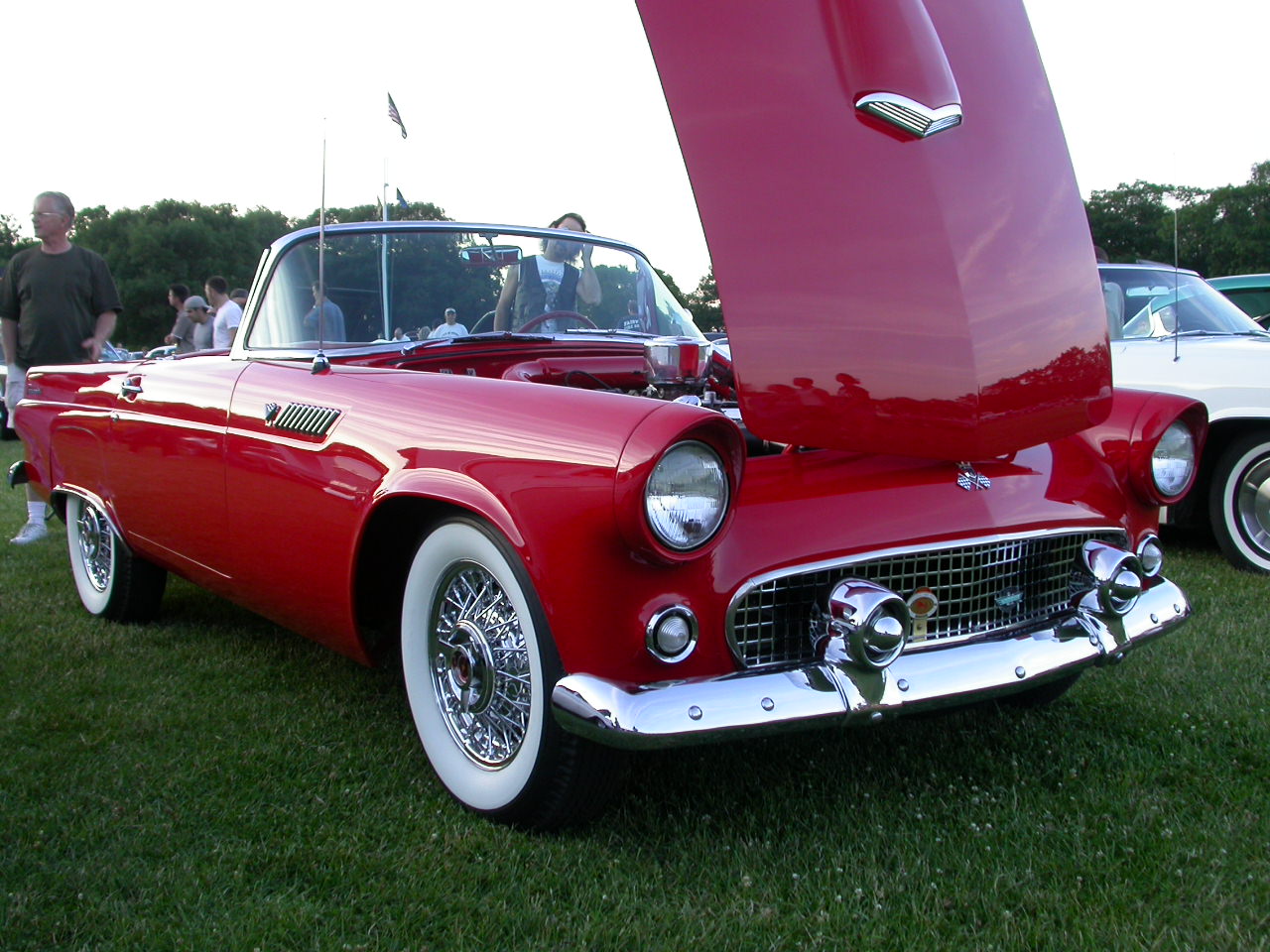1955 Ford Thunderbird Roadster
The Ford Thunderbird is an American automotive icon first introduced in 1955. During the early 1950's, military men were returning from fighting in World War II. In Europe, the style of vehicle was very different from the Detroit American car. The graceful but sporty MG, Triumphs, and Jaguar's, to name a few, had found their way into the hearts of many of these serviceman. The American automobile manufacturers noticed this trend and felt there was a strong market to support a small sportscar.
The Chevrolet was one of the first, if not the famous, of the Detroit auto-manufacturers to test the market with the introduction of their Corvette. Not wanting to be left behind, Ford entered with their Thunderbird.
Lewis D. Crusoe, Frank Hershey, and George Walker are considered the creators of the Thunderbird. Crusoe was a retired GM executive; Hershey was a designer for Ford; and Walker was the chief stylist for Ford. While Crusoe and Walker were in Paris, they saw a sports car and were instantly inspired. They convinced Hershey to create designs and the result was an open car with room for two passengers. As with all cars, deciding upon a suitable name is difficult. There were well over 5000 suggestions, with the one submitted by Alden Giberson behind selected. The name Whizzer had been seriously considered but was dropped for Gibersons suggestion, the Thunderbird.
The Thunderbird, though similar, was different in many ways to the Corvette and the rest of the small sports cars being offered. The Thunderbird was created as a 'personal luxury' car and even to the current production version, has never been designed as a sports car. Instead of fiberglass, the Thunderbird was constructed of metal. Instead of six cylinder engines, Ford upped-the-ante with a V8. To keep cost and development at a minimum, it used as many parts as possible from the other Fords of that era. The result was a two-seater with many creature comforts and impressive styling. Manual and automatic transmissions were both available. The instrument panel was home to a tachometer, clock and a 150 mph speedometer. The suspension was comprised of a ball-join in the front, offering a plush ride.
The Thunderbird was first debuted to the public at the 1954 Detroit Auto Show, though it was still in concept form. The production version varied slightly. In September of that same year, the first production Thunderbird was completed and ready for sale. It was only available as a convertible. A popular option, the removable hardtop with circular portholes was available. During its introductory year, over 16000 examples were produced.
A 292 cubic-inch V8, depending on the configuration, ranged in horsepower from 193 through 212. A year later, the horsepower rose to a base of 215 and a high of 340 from the 292 and 312 cubic-inch engines. Ventilation was improved with the addition of side vents. The exhaust pipes were moved to the ends of the bumper. By moving the spare wheel to the outside, the trunk space was enlarged and the Continental Kit was born. Production for 1956 was down just a little but still strong with over 15,600 examples being produced.
1955 Model of black classic car Ford Thunderbird
The Thunderbird received styling changes in 1957 with a reshaped bumper and an enlarged grille. In the rear, the tailfins grew in size and became more pointed. The round tail-lights also grew in size. The spare tire was again housed inside the trunk. The big news was under the hood with versions of the 292 and 312 cubic-inch engines being offered. The base engine was the 292 offering just under 200 horsepower. The top of the line configuration was the F-code 312 with the NASCAR racing kit performance package, boosting horsepower to 340. The F-code, in non-NASCAR racing kit form was popular; with the help of a single four-barrel carburetor and supercharger it produced around 300 horsepower. The E-code 312 engine option, another popular engine choice, was equipped with two four-barrel carburetors and produced 270 horsepower. In total, 1957 was a great year for the Thunderbird, both in performance and in sales with over 21300 examples being produced. The 1957 season actually had three extra months of production because the 1958 models were not ready to be sold. On December 13, 1957, the last of the first series of Thunderbirds was produced and marked the end of two-seater Fords until the 1982 Ford EXP. A two-seater Thunderbird would not reappear until 2002. In total, over 53,160 examples had been produced from 1954 through 1957.
The major complaint of many of the owners of the 'Classic' or 'Little Bird' Thunderbirds had been due to its size, mainly because there was no back seat and limited trunk space. The next version of the Thunderbird addressed both of these issues.
The second series of the Thunderbird was produced from 1958 through 1960 and are commonly referred to as the 'Squarebirds' due to their design. The designs of the Corvette and the Thunderbird went in different directions with the Thunderbird continue to further evolve into the luxury car segment. Robert McNamara, the CEO of Ford at the time, made the final decision to morph the 2-door Thunderbird into a four-door. The decision was made in an attempt to increase sales.


